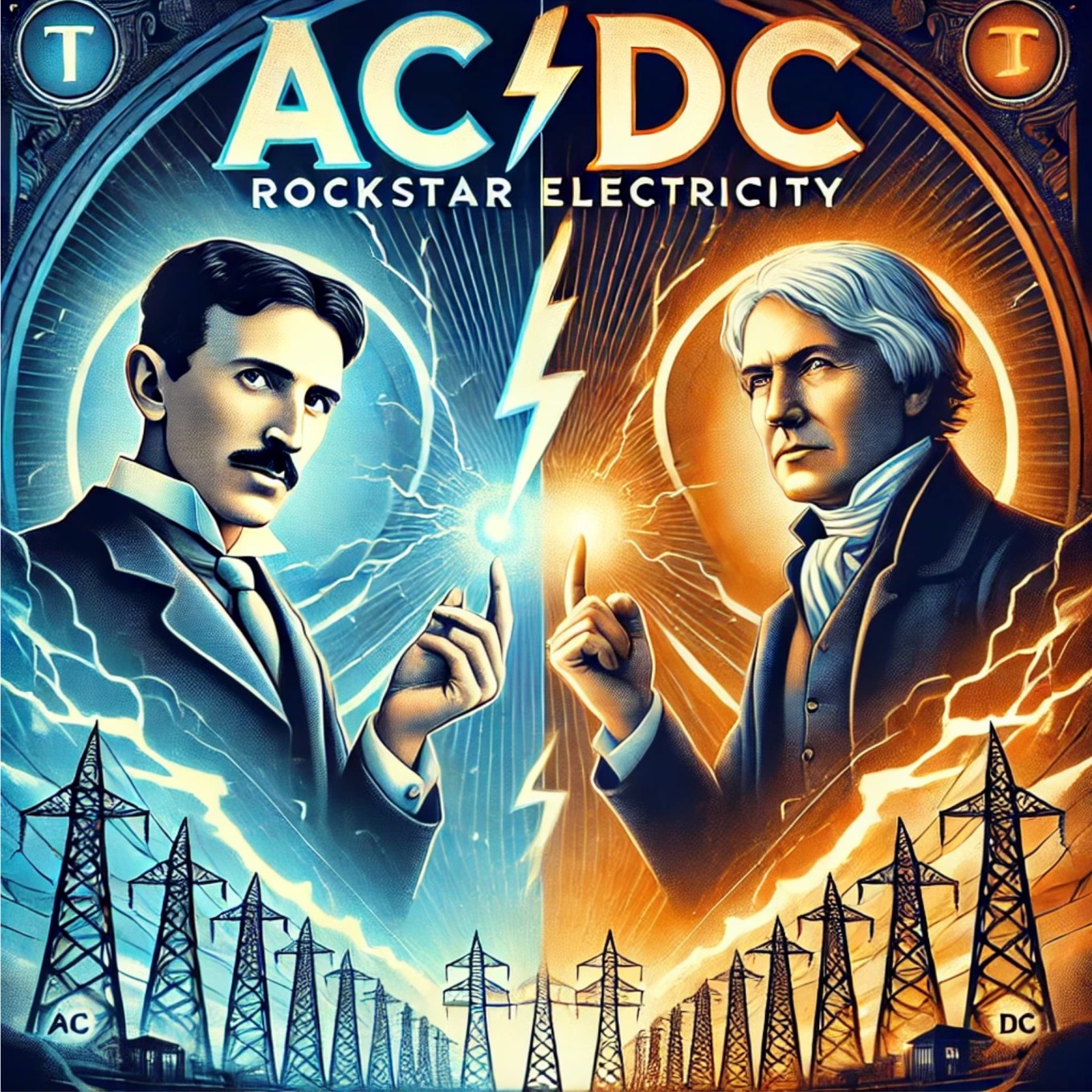Electricity powers our modern world, but the story of how we got here is a tale of rivalry, innovation, and groundbreaking discoveries. The battle between Alternating Current (AC) and Direct Current (DC) was one of the most electrifying conflicts in scientific history—literally! This article explores the origins of AC and DC, their evolution, and how they continue to shape our lives today.
The Early Sparks of Discovery
The story of AC and DC begins in the early days of electricity. In the late 18th century, scientists such as Benjamin Franklin and Luigi Galvani were making discoveries about electrical charge and conduction. But it wasn’t until the early 19th century that electricity began to be harnessed in practical applications.
One of the pioneers in the field was Alessandro Volta, who invented the first true battery, known as the Voltaic Pile, in 1800. This battery produced a steady direct current (DC), meaning that electricity flowed in only one direction. This discovery laid the foundation for early electrical applications.
The Rise of Direct Current (DC)
In the late 19th century, Thomas Edison became one of the most famous advocates of direct current. He developed the first commercial power system in New York City in 1882, using DC to power lights and other electrical devices. DC was ideal for short distances, but it had a major flaw—it was difficult to transmit over long distances without significant power loss.
Edison, being a strong proponent of DC, established power stations in various locations. However, because of the voltage drop over long distances, power plants had to be placed close to consumers, making the system expensive and impractical for widespread use.
Tesla’s Journey: From Edison to Westinghouse
One of the most pivotal figures in electrical history, Nikola Tesla, initially worked for Thomas Edison. In the 1880s, Tesla was hired by Edison’s company to improve DC generators. Tesla proposed innovative ideas for electrical efficiency, but Edison, a staunch supporter of DC, dismissed Tesla’s work and allegedly refused to pay him a promised bonus for his innovations. Frustrated, Tesla resigned and set out to develop his own revolutionary electrical system.
Tesla’s work eventually caught the attention of George Westinghouse, an industrialist who saw the potential in Tesla’s alternating current (AC) system. Westinghouse purchased Tesla’s AC patents and supported his research, leading to the development of an efficient system for long-distance power transmission.
The Alternating Current (AC) Revolution
While Edison was promoting DC, another brilliant inventor, Nikola Tesla, was developing an alternative solution—alternating current (AC). Unlike DC, AC could easily be transformed to higher or lower voltages using a transformer, making it far more efficient for long-distance transmission.
George Westinghouse, an industrialist and engineer, recognized the potential of Tesla’s AC system and supported its development. Together, they improved AC technology, making it a serious competitor to Edison’s DC system.

The War of the Currents
The late 1880s and early 1890s saw the infamous “War of the Currents” between Edison (DC) and Tesla & Westinghouse (AC). Edison launched aggressive campaigns against AC, claiming it was dangerous. He even demonstrated AC’s lethal potential by using it to electrocute animals and promoting its use in the electric chair to damage AC’s reputation.
Despite Edison’s efforts, AC proved to be the superior system for widespread power distribution. In 1893, the Chicago World’s Fair was lit up by Westinghouse’s AC system, demonstrating its effectiveness to the world. Then, in 1896, the Niagara Falls Power Plant used AC to transmit electricity over long distances, solidifying its dominance in electrical distribution.
Advantages of AC:
- Efficient Long-Distance Transmission – AC can be easily stepped up or down using transformers, reducing power loss over long distances.
- Lower Infrastructure Cost – Power plants can be built far from populated areas, making large-scale power generation more feasible.
- Safer for Home Use – AC is generally safer for household wiring because it can be controlled at different voltages.
- Easier to Convert – AC can be easily converted to different voltages using transformers.
- Standard for Power Grids – AC is the global standard for electricity distribution, making it widely available.
- Compatible with Most Electrical Appliances – Most household devices, such as refrigerators and lights, run on AC.
- Reliable for Industrial Use – AC is ideal for powering heavy machinery and industrial applications.
- Less Energy Loss in Transmission – High-voltage AC transmission reduces energy losses over long distances.
- Can Be Generated Efficiently – AC generators (alternators) are simpler and more durable than DC generators.
- Easier to Control Frequency – AC allows frequency regulation, which is crucial for grid stability.
Disadvantages of AC:
- More Dangerous at High Voltages – High-voltage AC can be deadly upon contact.
- Complex Electronics Need Conversion – Devices like computers and smartphones require AC-to-DC conversion.
- Reactive Power Losses – AC power transmission suffers from reactive power issues, which can reduce efficiency.
- Higher Risk of Electromagnetic Interference – AC transmission lines generate electromagnetic fields that can interfere with communication systems.
- Requires More Insulation – High-voltage AC lines need better insulation and spacing to prevent arcing.
- Transformer Dependence – AC needs transformers to change voltage, adding bulk and cost to power infrastructure.
- Power Factor Issues – AC systems require power factor correction to improve efficiency.
- Not Ideal for Battery Storage – Batteries store power in DC, making AC conversion necessary.
- Less Efficient for Some Electric Motors – Some motors, like brushless DC motors, perform better with DC.
- Noise in Audio and Signal Applications – AC can introduce electrical noise, affecting sensitive audio and communication systems.
Advantages of DC:
- Ideal for Battery Storage – Batteries store DC power, making it ideal for mobile devices and renewable energy systems.
- More Efficient for Electronics – Most modern electronics run on DC, eliminating the need for AC conversion.
- Lower Energy Losses in Low-Voltage Applications – DC transmission reduces energy losses in low-voltage applications.
- Safer at Low Voltages – Low-voltage DC systems pose less risk of electric shock.
- Better for Solar and Wind Power – Renewable energy sources generate DC power, making integration easier.
- Does Not Suffer from Frequency Issues – DC does not require frequency regulation like AC.
- Efficient for LED Lighting – LEDs work more efficiently with DC than AC.
- Less Electromagnetic Interference – DC generates less interference than AC, making it ideal for precision electronics.
- More Efficient for Certain Motors – Some motors, like brushless DC (BLDC) motors, are more efficient than AC motors.
- Growing Use in HVDC Transmission – High-Voltage Direct Current (HVDC) transmission is becoming popular for ultra-long-distance electricity transport with reduced losses.
Disadvantages of DC:
- Difficult to Transmit Over Long Distances – Without efficient conversion, DC suffers high power losses over long distances.
- Voltage Conversion is Complex and Expensive – Unlike AC, DC requires complex electronics for voltage transformation.
- Less Standardized for Power Grids – DC is not the standard for power transmission, limiting its widespread adoption.
- Expensive Infrastructure – DC transmission requires special converters, making it costlier to implement.
- Requires More Maintenance in Some Applications – DC motors and generators require more maintenance than their AC counterparts.
- Limited Use in Household Applications – Most home appliances are designed for AC power.
- High-Voltage DC is Dangerous – While low-voltage DC is safe, high-voltage DC can be extremely hazardous.
- Incompatible with Traditional Transformers – DC does not work with standard transformers, requiring advanced conversion technology.
- Less Developed Technology – While improving, DC transmission technology is still less advanced compared to AC grids.
- Higher Initial Costs – Setting up a DC-based power system requires more expensive components.
The Modern Coexistence of AC and DC
Today, both AC and DC play crucial roles in our electrical systems:
- AC remains the standard for power transmission and household electricity.
- DC is essential for batteries, electronics, and renewable energy systems like solar panels.
- Hybrid Systems are emerging, such as High-Voltage Direct Current (HVDC) for efficient long-distance power transmission.
Final Thoughts

The battle between AC and DC shaped the future of electricity. While AC won the “War of the Currents,” DC has made a resurgence in modern technology. Thanks to Tesla, Westinghouse, and Edison, we live in an electrified world where both currents power our homes, industries, and innovations.
Electricity is indeed the rockstar of modern civilization—and its story is one of competition, controversy, and ultimate cooperation. The legacy of AC and DC continues to evolve, proving that, in the world of energy, the sparks never stop flying!
At Nice Future Inc., we are committed to sharing technology insights and helping businesses navigate the complexities of IoT, IT, and emerging innovations. If you need expert guidance on any IT business challenges, from system upgrades to infrastructure maintenance, we’re here to assist. Just give us a call, and let’s power the future together!
Contact us today to discuss your project needs or schedule an update! Together, we’ll ensure that your business stays on track and keeps moving forward.
Subscribe to our newsletter!




